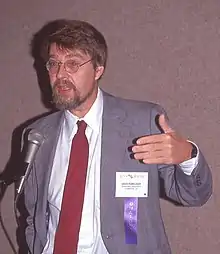David Rumelhart
David Everett Rumelhart (June 12, 1942 – March 13, 2011)[1] was an American psychologist who made many contributions to the formal analysis of human cognition, working primarily within the frameworks of mathematical psychology, symbolic artificial intelligence, and parallel distributed processing. He also admired formal linguistic approaches to cognition, and explored the possibility of formulating a formal grammar to capture the structure of stories.
David E. Rumelhart | |
|---|---|
 David Rumelhart at the International Joint Conference on Neural Networks (IJCNN) in Seattle on 8 July 1991 | |
| Born | June 12, 1942 |
| Died | March 13, 2011 (aged 68) |
| Nationality | American |
| Known for | Connectionism Artificial neural network modeling Deep Learning Applications of backpropagation |
| Awards | MacArthur Fellowship (July 1987) National Academy of Sciences Warren Medal of the Society of Experimental Psychologists APA Distinguished Scientific Contribution Award University of Louisville Grawemeyer Award (2002) |
| Scientific career | |
| Fields | Psychology |
| Institutions | Stanford University University of California, San Diego |
| Thesis | The Effects of Interpresentation Intervals on Performance in a Continuous Paired-Associate Task (1967) |
| Doctoral advisor | William Kaye Estes |
| Doctoral students | Michael I. Jordan |
Biography
Rumelhart was born in Mitchell, South Dakota on June 12, 1942. His parents were Everett Leroy and Thelma Theora (Ballard) Rumelhart.[2] He began his college education at the University of South Dakota, receiving a B.A. in psychology and mathematics in 1963. He studied mathematical psychology at Stanford University, receiving his Ph.D. in 1967. From 1967 to 1987 he served on the faculty of the Department of Psychology at the University of California, San Diego. In 1987 he moved to Stanford University, serving as Professor there until 1998. Rumelhart was elected to the National Academy of Sciences in 1991 and received many prizes, including a MacArthur Fellowship in July 1987, the Warren Medal of the Society of Experimental Psychologists, and the APA Distinguished Scientific Contribution Award. Rumelhart, co-recipient with James McClelland, won the 2002 University of Louisville Grawemeyer Award in Psychology.[3]
Rumelhart became disabled by Pick's disease, a progressive neurodegenerative disease, and at the end of his life lived with his brother in Ann Arbor, Michigan. He died in Chelsea, Michigan. He is survived by two sons.[2]
Work
Rumelhart was the first author of a highly cited paper from 1985[4] (co-authored by Geoffrey Hinton and Ronald J. Williams) that applied the back-propagation algorithm (also known as the reverse mode of automatic differentiation published by Seppo Linnainmaa in 1970) to multi-layer neural networks. This work showed through experiments that such networks can learn useful internal representations of data. The approach has been widely used for basic cognition researches (e.g., memory, visual recognition) and practical applications. This paper, however, does not cite earlier work of the backpropagation method, such as the 1974 dissertation[5] of Paul Werbos.
In the same year, Rumelhart also published Parallel Distributed Processing: Explorations in the Microstructure of Cognition[6] with James McClelland, which described their creation of computer simulations of perceptrons, giving to computer scientists their first testable models of neural processing, and which is now regarded as a central text in the field of cognitive science.[1]
Rumelhart's models of semantic cognition and specific knowledge in a diversity of learned domains using initially non-hierarchical neuron-like processing units continue to interest scientists in the fields of artificial intelligence, anthropology, information science, and decision science.
In his honor, in 2000 the Robert J. Glushko and Pamela Samuelson Foundation created the David E. Rumelhart Prize for Contributions to the Theoretical Foundations of Human Cognition.[1][7] A Review of General Psychology survey, published in 2002, ranked Rumelhart as the 88th most cited psychologist of the 20th century, tied with John Garcia, James J. Gibson, Louis Leon Thurstone, Margaret Floy Washburn, and Robert S. Woodworth.[8]
References
- Carey, Benedict (March 18, 2011). "David Rumelhart Dies at 68; Created Computer Simulations of Perception". The New York Times.
- "Profile details: David Everett Rumelhart". Marquis Who's Who.
- "David E. Rumelhart: A Scientific Biography". Archived from the original on 2013-10-30. Retrieved 2016-02-03.
- Rumelhart, David E.; Hinton, Geoffrey E.; Williams, Ronald J. (1986-10-09). "Learning representations by back-propagating errors". Nature. 323 (6088): 533–536. Bibcode:1986Natur.323..533R. doi:10.1038/323533a0. ISSN 1476-4687. S2CID 205001834.
- Werbos, Paul (November 1974). Beyond regression: New tools for prediction and analysis in the behavioral sciences (PhD). Harvard University.
- David E. Rumelhart, James L. McClelland and PDP Research Group (1987). Parallel Distributed Processing: Explorations in the Microstructure of Cognition. ISBN 9780262680530. Retrieved 2016-02-03.
- "Message 1: THE RUMELHART PRIZE Announcement and Call for Nominations". linguistlist.org.
- Haggbloom, Steven J.; Warnick, Jason E.; Jones, Vinessa K.; Yarbrough, Gary L.; Russell, Tenea M.; Borecky, Chris M.; McGahhey, Reagan; Powell, John L., III; et al. (2002). "The 100 most eminent psychologists of the 20th century". Review of General Psychology. 6 (2): 139–152. doi:10.1037/1089-2680.6.2.139. S2CID 145668721.
{{cite journal}}: CS1 maint: multiple names: authors list (link)